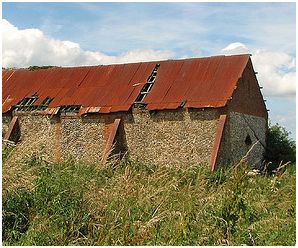The questions, comments and concerns never seem to end in my profession. Part of what helps to keep things interesting for me after more than three decades.
Today a client asks:
 “I would like to see what the credit would be to omit the steel siding. the red rust really bothers me so I am thinking I may go fiber cement.”
“I would like to see what the credit would be to omit the steel siding. the red rust really bothers me so I am thinking I may go fiber cement.”
Unless the goal is to purposefully try to create a building with the weathered “old west” look of rusted corrugated steel (think “Big Thunder Mountain Railroad” at Disneyland), I have to admit red rust really bothers me too.
Under what conditions would steel siding ever have a red rust issue?
Corten is a product which is purposefully rusted steel (back to standing in line at Disneyland), so obviously it is going to red rust.
Over time, bare galvanized steel will red rust. Bare steel (not galvanized at all) will red rust (oxidize) in a matter of minutes.
Unpainted galvanized steel is designed not to rust. Galvanization involves a zinc coating on the steel, which corrodes instead of the actual metal to prevent rust. When the zinc is all gone is when real rust sets in. If galvanized steel panels are rusted, it means the zinc has worn off completely in those areas. The speed at which rust appears is a factor of the amount of galvanization on the steel (the “tighter” the spangle pattern is on the steel, the greater the galvanization), as well as the climactic conditions of the building site. Close to the ocean or corrosive atmospheric conditions (acid rain)? Tough conditions like these will induce red rust much more quickly.
However, very few pole buildings (or in this client’s case a horse barn) are constructed with unpainted steel siding. Factory pre-painted steel is now the product of choice for siding and roofing due to its strength, durability, and ease of installation and relatively low cost.
If stored, handled, installed or maintained incorrectly painted steel siding can rust. Most frequent causes of rust are when small steel chips (or swarf) from cutting panels become embedded in the paint surface. In most cases, the rust is from the swarf itself, not from the underlying steel panel. How do you prevent this from happening? Take a soft cloth and carefully wipe off the swarf after cutting the panels.
Deep scratches, which extend through the paint and galvanized coating underneath, can also result in red rusting. Again, how to fix this? Get the factory produced touch up paint, which is not inexpensive – but well worth the investment to fill in those scratches. With care in cutting and handling, you should not need touch up paint.
The reality of the situation is – rarely is red rust going to be an issue.






